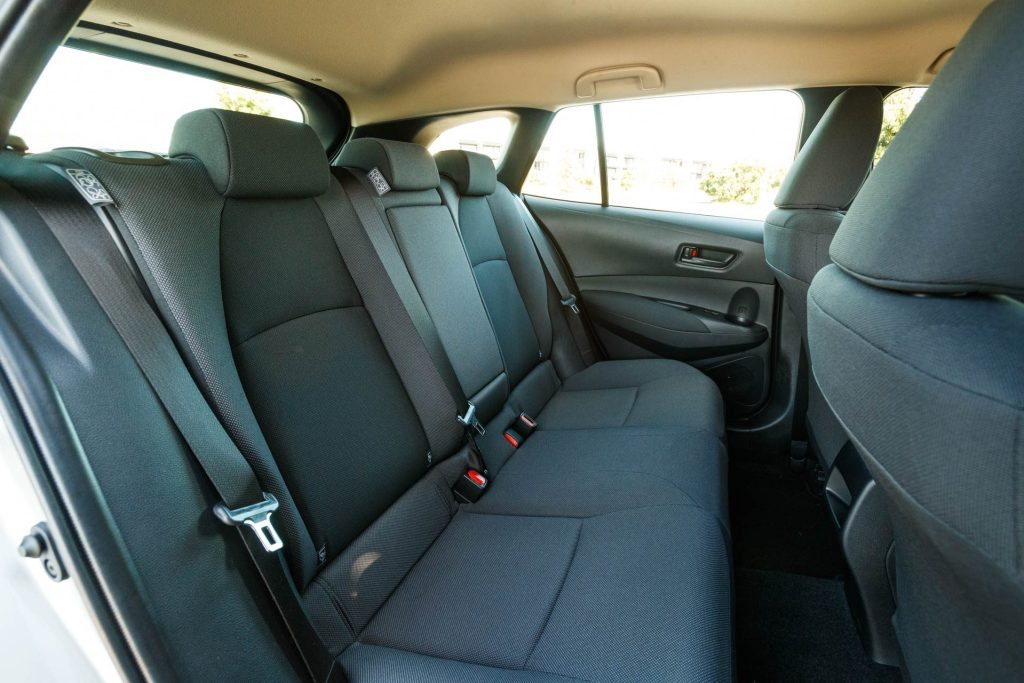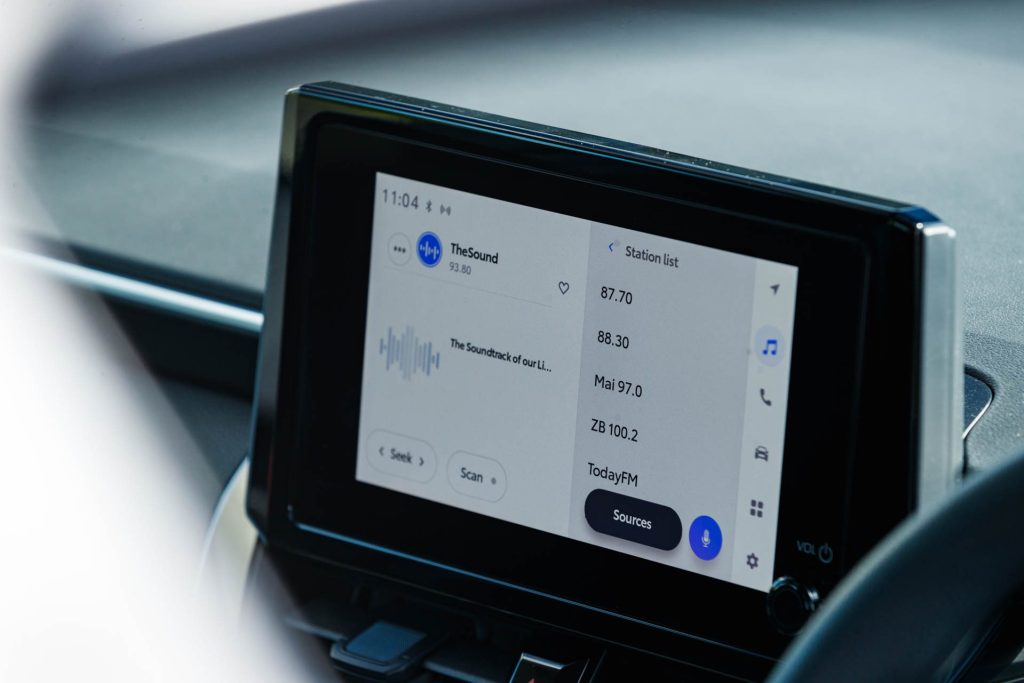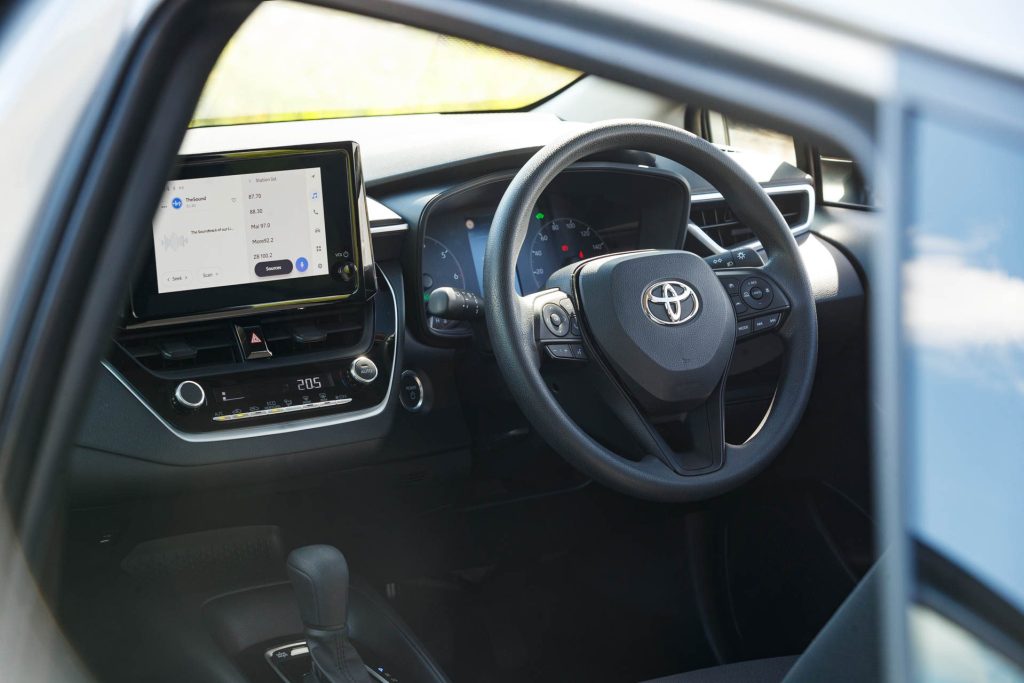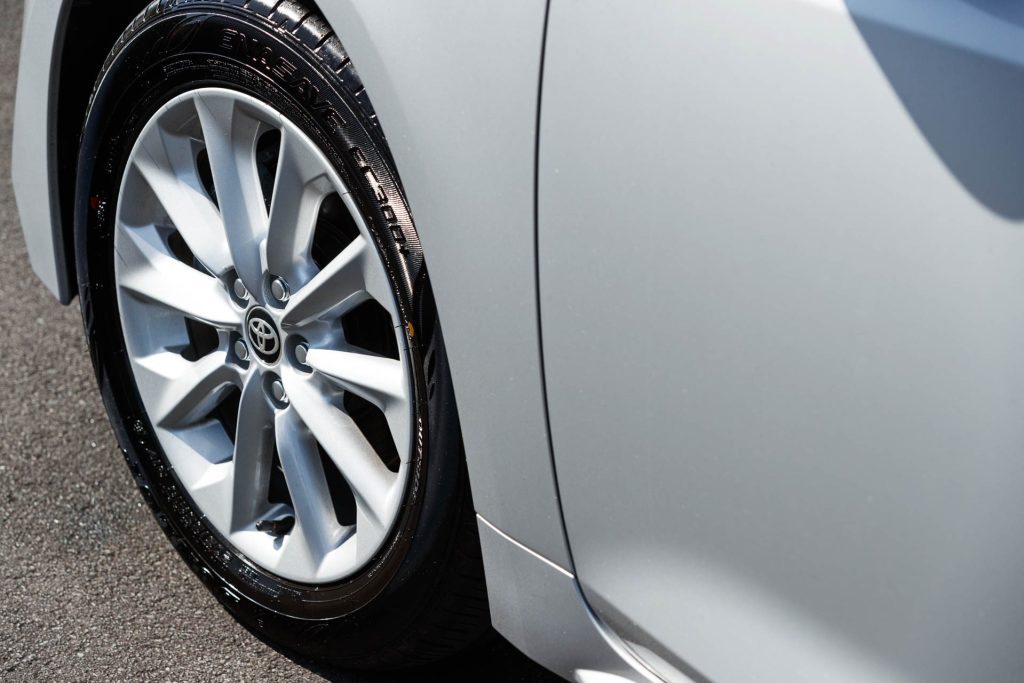It’s an okay looking machine at least, better to our eyes than the more in-demand Corolla Cross. It’s a little front heavy, that overhanging nose grinding into the odd driveway, but they’ve given the GX a set of alloy wheels this time around. There’s a semblance of a lower body kit and, with it’s elongated tail, it’s better proportioned than the hatch.
Open that sloping tailgate, an easy job without a pointless powered lifter, and you’ve got a wide and long boot area, making it more practical than the 208L receptacle in the hatchback. And there’s a spring-loaded release for the back seats. These flop forward to give a flat load area.

The back seat has space enough, with good headroom, though three across would be a squeeze. And while there are no charge points, you get Isofix and bottle holders. The GX has what we’ll describe as a utilitarian interior; it has none of the frills yet it’s hardly lacking either.
While soft-touch interior trim is listed on the spec sheet, we struggled to find any – it’s on the very top of the dash – with hard (wearing) plastic everywhere else. It’s tight though, and everything feels built to do 250,000 kays.
This has the necessities without the frippery. No digital dash but the little LCD screen in between the dials relays enough information. The updated eight-inch touch screen has a much improved resolution but limited functionality. There’s a solitary USB-C plug for CarPlay or Android Auto. The single-zone air conditioning is controlled by good old buttons.

While the wagon doesn’t have an ANCAP rating (it’s not sold across the ditch) this has all of Toyota’s safety sensing stuff; lane keeping (not too intrusive either, but easily deactivated if it really bothers you), auto high beams and active cruise which works well in traffic while keeping you centred in your lane on the motorway.
With a smart key rounding out the spec, this has everything you need and nothing you really don’t.
It’s an easy drive too. The steering is thoroughly decent, with a refined assistance and a semblance of connection. There’s a genuine smoothness to the powertrain’s delivery that other hybrids can’t match.
Now in its fifth generation, the hybrid system has been overhauled.
The components are lighter, more compact and there’s a new motor generator along with a smarter, more efficient control unit that’s also said to help reduce noise. Here, a 1.8-litre engine is assisted by a 70kW/185Nm motor, and the system’s not lacking for easy commuting torque. There’s also a smaller, lighter lithium-ion battery with a higher output, meaning more electric running in town operations.

With the motor doing most of the pulling, you rarely require more than about 2500rpm from the engine in the city. And then it settles back down to a hushed cruise at around 1200rpm, or it turns itself off altogether. These latest hybrids can do good distance on battery power, and they seem to ‘self charge’ more quickly as well.
At the end of each journey, you get a summary on the trip computer. A few crosstown journeys of between 10 and 15km returned an average of 2.5L/100km, thanks to an EV driving ratio of 80 per cent plus. Overall we got 4.2L/100km, the fuel test figure being 3.8L/100km.
There are a few drive modes, including ‘EV’ but best not to worry; just whack it into D and go. It’s fairly easy on gas no matter how you drive it but one eco tip; once up to speed, lift off the throttle and this usually puts the engine to sleep. Then the motor is able to maintain your speed, even up small gradients. The brake pedal, like the rest of the package, has a smooth action, only feeling a little weird when pressed hard.
Its ride is good too, being supple over both town and country roads. Out there, it turns faithfully, the steering responsive and the rear end with its independent wishbone set-up is stable, allowing the front end to hold on nicely.

At higher speeds, the responsiveness of the hybrid powertrain has vastly improved over what went before it, even better if you click it into the Sport mode, where e-CVT keeps a shorter ratio to further improve responsiveness.
Other sweeteners include the Toyota Fixed Price servicing regimen which means your hybrid can be serviced every 15,000km for $305. Keep that up, and your standard three-year warranty will be extended to five years/150,000km.
The price is now $35,990, making it great value for those looking for practical low-emission motoring. But as with most Toyota’s these days, you simply can’t get one, supply issues an ongoing problem. As such, all new Corolla orders are not expected to be delivered until 2024.
| Model | Toyota Corolla Wagon GX Hybrid |
| Price | $35,990 |
| Engine | 1798cc, IL4 |
| Power/Torque | 72kW/142Nm |
| Drivetrain | e-CVT, FWD |
| Fuel Use | 3.8L/100km |
| C02 Output | 88g/km |
| 0-100km/h | 9.1sec |
| Weight | 1400kg |


